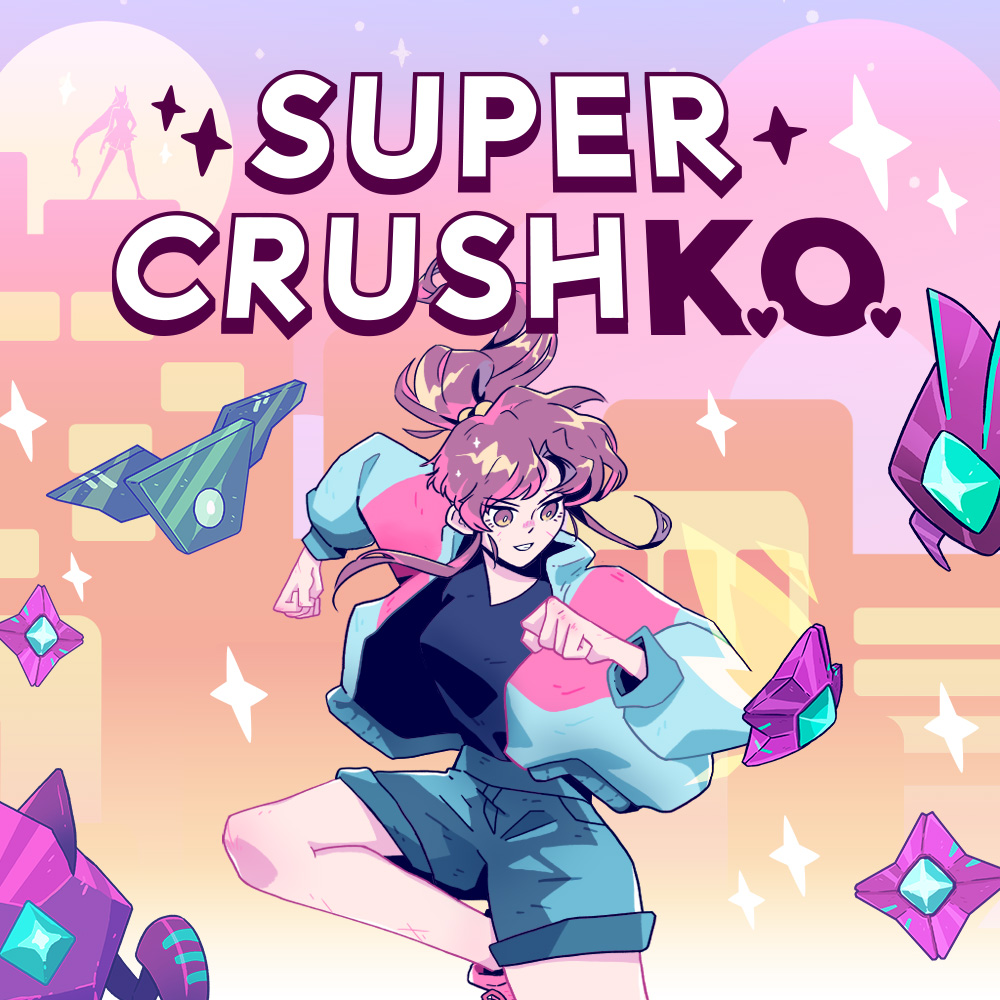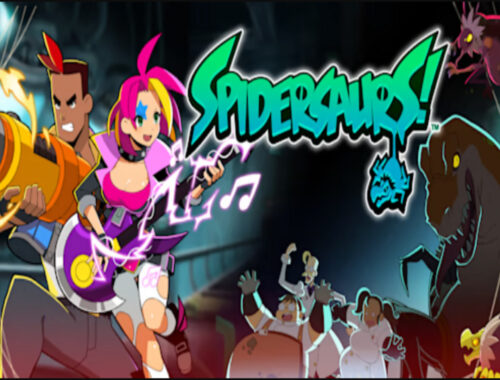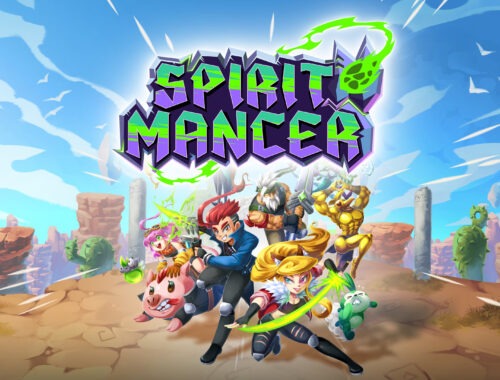River City Girls Review
Fast Facts
Title: River City Girls
Developer: WayForward Technologies
Publisher: Arc System Works
Website: https://wayforward.com/rivercitygirls/
Genre: Adventure, Arcade
Platform: Nintendo Switch
Age Rating: PEGI 12
Release Date: 05/09/19
Price: £26.99 – Rapid Reviews was very kindly provided with a review code for this title.
Introduction
It’s been nearly four months since River City Girls released and I finally got my hands on a review copy. I intended to buy it way back in September, but between my game reviewing responsibilities and my crippling addiction to Slay the Spire, it hadn’t happened. Instead, I was left to review Stay Cool, Kobayashi-San!: A River City Ransom Story.
If you read that review, you know that I was about as disappointed as that kid on Twitter who asked for Minecraft for Christmas but was gifted Mein Kampf instead. In fact, that garbage book would have been preferable to Stay Cool as it has the utility of squashing bugs and providing warmth when burned. In contrast, the only utility Stay Cool provides is robbing Hard Drive space until you inevitably delete it.
I was able to secure a review code for River City Girls but as I ran to the eShop with my new found trophy I was worried that whatever decisions that led to Stay Cool being what it is may have also been inflicted on this title. Within ten minutes of booting it up that fear was as dead as the pixilated baddies, I was kicking and punching across the screen. By the end of it, I concluded that River City Girls is not only my favourite game in the ever-expanding Kunio-Kun series but one of the best 2D side-scrolling beat ‘em ups I have ever played. River City Girls is a near-masterpiece of button mashing greatness.
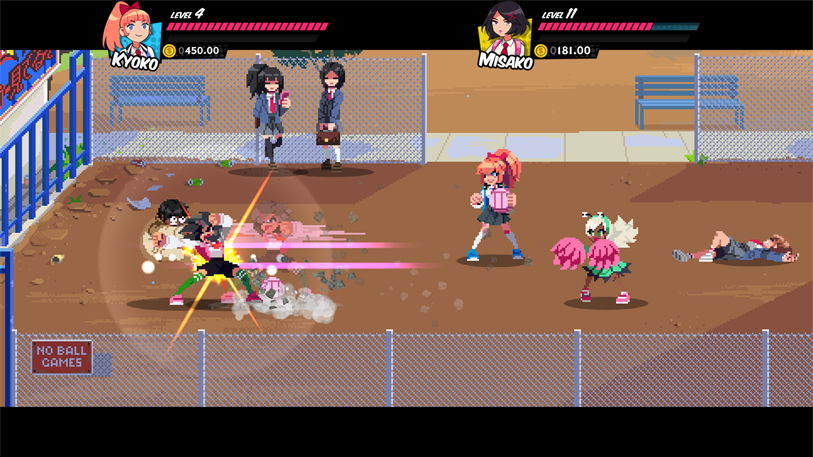
Narrative
The story setup is about as in-depth and intricate as tomato soup, which is to say, not very. That’s par for the course with games in this genre as narrative tends to get in the way of all the bone-breaking and face stomping. The gist of it is your boyfriends have been kidnapped, and it’s up to you and your BFF to fight your way through the city to rescue them. It’s the oldest trope in gaming but is a clear nod to its Kunio-Kun/Double Dragon roots.
With more in common with Taken than Cagney & Lacey (ask your parents) the girls interact with a litany of colourful and often odd characters as they gather information on their boyfriend’s whereabouts. These do a great job of breaking up the inherent monotony of punching and kicking people for eight hours while expounding humorously on the lore of River City.
Gameplay
River City Girls is a single or two-player couch co-op side-scrolling beat ‘em up based in the Kunio-Kun/River City Ransom world. You start the game as either the tough and take charge Misako or the clueless but sweet Kyoko. Both ladies share a common move-set but also employ moves unique to themselves. What starts as a somewhat limited assortment of attacks eventually becomes an arsenal as the girls gain experience points and money from defeating enemies. Some moves are gifted as the player gains rank, but dojos located throughout the city offer a menu of attacks to choose from, including special attacks, providing the player is of high enough level and has the money to purchase them.
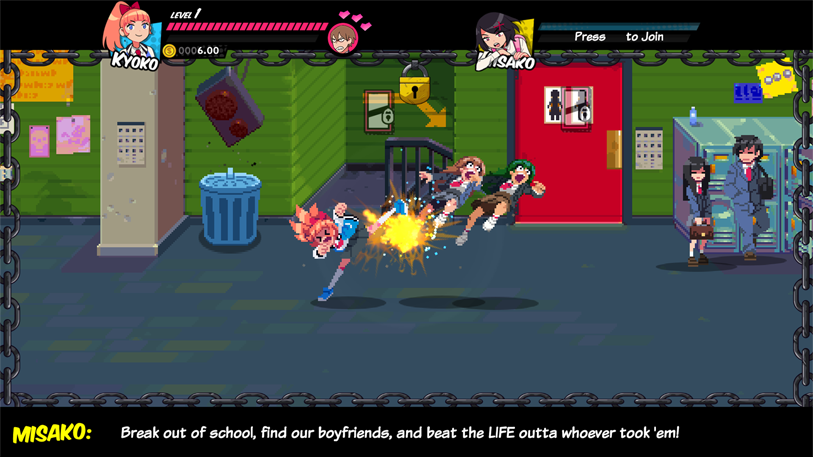
It’s not all about shaking down goons for change. Periodically, NPCs will task the player with errands that when completed result in a large haul of experience points, cash, and a buff item. These items usually revolve around “girly” things like lipstick, false eyelashes, compacts, etc. and offer a unique buff to combat. It’s important to look your best when feeding criminals concrete.
Everybody was Kung-Fu fighting
Of course, this being a Kunio game, weapons are lying around all over the place. Bats, chains, whips…yo-yos? Weapon choices are as eclectic as they are abundant and give that extra power and/or reach needed to turn a battle. Even background objects like trashcans and bicycles can be used as weapons. In River City, there is no shortage of ways to maim people, but that doesn’t mean that our protagonists are without mercy. Now and then, an enemy will drop to their knees and beg for their life. If granted, they ally with your cause and become a supporting character allowing the player to tag them into a fight for a quick attack – in much the same way as they do in the Marvel Vs Capcom games.
All of this combines into an à la carte combat system that is easily accessible to newcomers while offering veterans a level of customization and personal style rarely seen in this type of game. Button mashers will feel just as at home as tournament level fighters will while playing River City Girls and that I feel is its greatest strength and the thing that separates it most from its counterparts. Now, let’s talk about how gorgeous it looks and sounds…
Graphics
The thing that first drew me into River City Girls is the astounding sprite work. As a fan of pixel art, I was thrilled to take it all in. And there’s a lot to take in. I could barely keep my eyes on the action as they darted about the screen, awash in wonder. The character designs, created in part with manga artist Priscilla Hamby, are a beautiful amalgamation of bubblegum pop and Eastern influences exhibiting sharp silhouettes and bold colour choices. The backgrounds, large and sprawling are full of detail and are reminiscent of those from one on one fighting games like Street Fighter. People litter the areas waiting for buses and loiter around storefronts staying away from but watching in earnest the carnage of your search. The world feels ‘busy’ and full of opportunity.

Audio
Had developer WayForward filled their retro-inspired brawler with chip-tune loops, not many folks would have faulted them for it. It would be keeping with tradition. Instead, they brought out the big amps and cranked it to eleven with one of the best OSTs of the year.
Christina Vee and NateWantsToBattle set the tone with the bouncy and driving title track followed by sombre yet sensual cuts from up and coming artist Megan McDuffee. In fact, there a handful of fully voiced and fully constructed songs from Megan playing throughout the game. When I joked with Megan that buying River City Girls was akin to buying a Megan McDuffee EP she pointed out that she had contributed over an hour of music to the project and is credited with fifty of the sixty-two tracks. She has a real talent for creating earworms evidenced by my atonal renditions of “Bully” while in the shower. Tracks from Chipzel and Dale North round out the offering, and you can listen to the whole thing below.
Presentation
For me, the most surprising aspect of the game is how slickly produced it is. From the title screen to the ending credits, every facet of River City Girls has been juiced in some way. For example; story exposition is delivered in numerous ways and styles. Sometimes that’s done through classic in-game sequences and dialogue boxes, sometimes through manga styled cut scenes that resemble a comic book and still other times through fully animated anime-like interludes – all of it fully voiced and with unique music and audio. Together, these expand the aesthetic while moving the story along entertainingly and engagingly.
That’s just one part of the game. I could go on about the flashy scene transitions, the Mario World-like end game transition, the in-game menu modelled after a cutesy smartphone, the art for shop interiors, and the many things not directly coming to mind as I write this. Suffice to say; River City Girls has received an extreme amount of polish that is apparent in every frame.
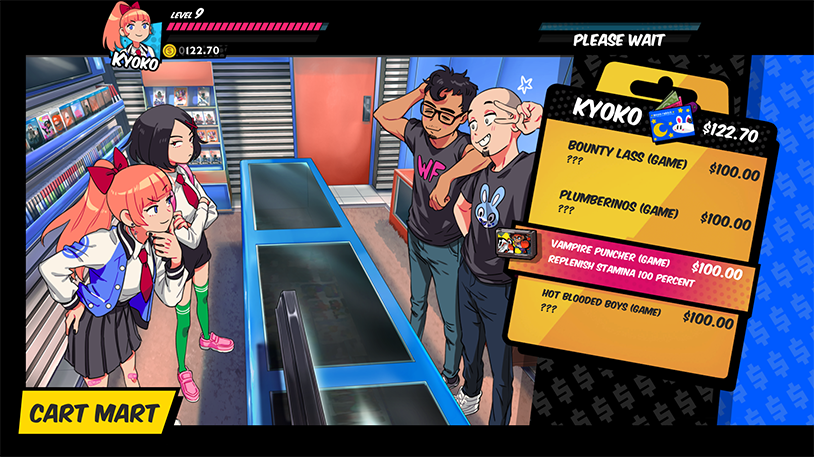
Perfection?
Everything I’ve written so far may lead you to believe that River City Girls is the greatest beat ‘em up ever released and is perfect in every way. The former is a matter of opinion, but the latter certainly is not. For all the many things this game does right, there are a few things that mar this otherwise valiant effort.
The most perplexing being the exits/entrances to areas. At the end of each area is a door icon that you activate with a button press to advance to the next area. So far, so good – doors do lead to new areas. The problem is that the button to activate the doors is the same button used to punch. This wouldn’t be much of an issue if the game didn’t surround these exits with enemies, which they do almost every time. This leads the player to exit the area when fighting inadvertently, usually leaving money behind. I don’t understand how such an obvious blunder got through QA.
FFS!
There are a few other issues that may needlessly frustrate players. When visiting shops, there is no way to tell the effects of the items for sale until purchased. This is a holdover from previous River City games where the money seemed to flow more freely than it does here. As such, the sense of discovery and risk is marred by River City Girls’ tight purse strings.
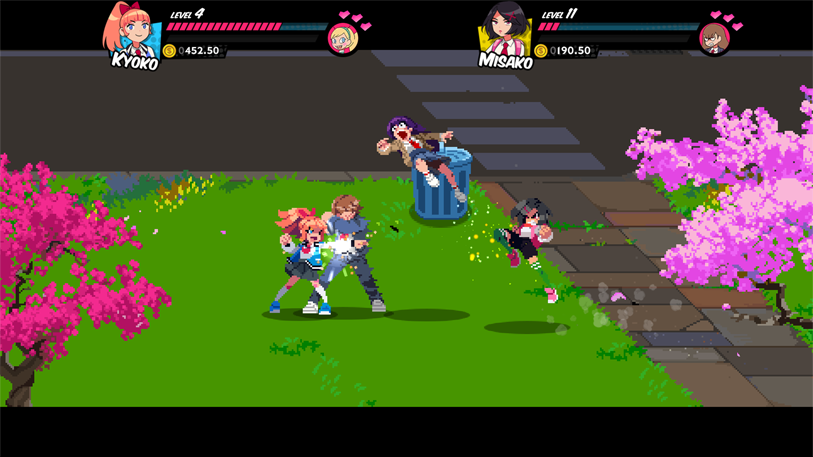
I jump now?
The core of RCG is classic Kuni-Kun, but it also takes inspiration from other games. A heavy peppering of Double Dragon is apparent and welcomed, but the obligatory platforming isn’t implemented very well. Falling to your death in a platforming game is an expected part of the process, but doing so multiple times over as you wrestle with controls and animations that don’t seem to take platforming into account is just frustrating. Maybe that’s why there aren’t many of them in the game. Which begs the question of why they’re in there at all?
While RCG does a great job of emulating the look and feel of an early 90s arcade brawler, it was indeed released in 2019. So, the absence of online play in a game with difficulty heavily tipped towards co-op is an interesting choice. Sure, if it were still the 1990s, I would have plenty of people to play with, but I would also be struggling with high school Spanish and getting beyond second base with my then-girlfriend – because I would’ve been a teenager. As an adult with adult friends whom all live adult lives, meeting up to sink seven hours into a video game isn’t very realistic.

Hibari!
These are just minor annoyances that don’t diminish the enjoyment of the game all that much for me. The second boss, though, Hibari, I would consider an egregious error in judgment. I love her character design, opening cinematic, and voice work, but I hope she dies in a fire. She’s just too difficult to defeat to be placed as the second boss. Especially so, considering the first boss is such a push-over.
I mentioned earlier that the game’s difficulty seems skewed toward having a second player in-game and that is true of Hibari and her whole shtick. It’s not impossible to defeat her in single player, I did it, but it took more attempts than I would like to admit and I may have even invented some curse words in the process. Bottom line, Hibari is a caca-knuckled potato headed cellar dweller that should have been placed towards the end of the game.
Conclusion
Nostalgia is a funny and powerful thing. It can inspire developers to create new chapters in the games they loved growing up. It can persuade gamers to part with their money for the promise of a trip down memory lane. And it can cause video game reviewers to gush over a new instalment and proclaim it as the latest masterpiece in a series. As a reviewer, I need to keep nostalgia at arm’s length when scoring a game. Its value differs with each player and as such can’t be quantified. My job is to relay to the reader a fair assessment of what a game is trying to do and how well it does it. With that I offer this;

Double Dragon was the first game I fell in love with. It was unlike any game I had experienced up to that point, and ten year old me was astounded with the amount of freedom the gameplay provided. Co-op mode meant that instead of my younger brother and I taking turns and only getting incrementally further in a game, we could combine our efforts and extend the life of our limited quarter supply. Paired Dragon became the standard-bearer I measured all other games against…well until Golden Axe came out.
Double Dragon is an off-shoot of River City Ransom and with RCG developer WayForward also being the Developer of the fantastic Double Dragon: Neon, it makes sense that RCG leans so heavily into it. This makes it tempting to evaluate it through rose-coloured glasses, but that wouldn’t be fair to the work that has been done.
I’ll take three
RCG is not merely a retro rebrand or love letter to a series – it’s an overhaul of a thirty-five-year-old genre. It takes the rose-tinted memories of how we remember these games to be and makes them a reality. Sure, like most things, it’s not perfect, but it strives to be and comes close. River City Girls is a not only a must-own for fans of River City/Double Dragon but also for fans of the beat ‘em up genre in general. In this reviewer’s opinion, River City Girls is one of the finest examples of its kind and should be celebrated.
Rapid Reviews Rating

You can purchase River City Girls from the Nintendo eShop on the following link, https://www.nintendo.co.uk/Games/Nintendo-Switch/River-City-Girls-1630325.html#Overview

